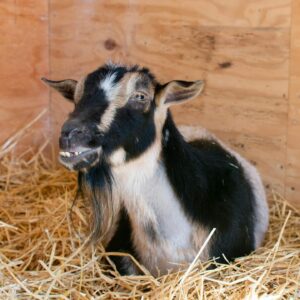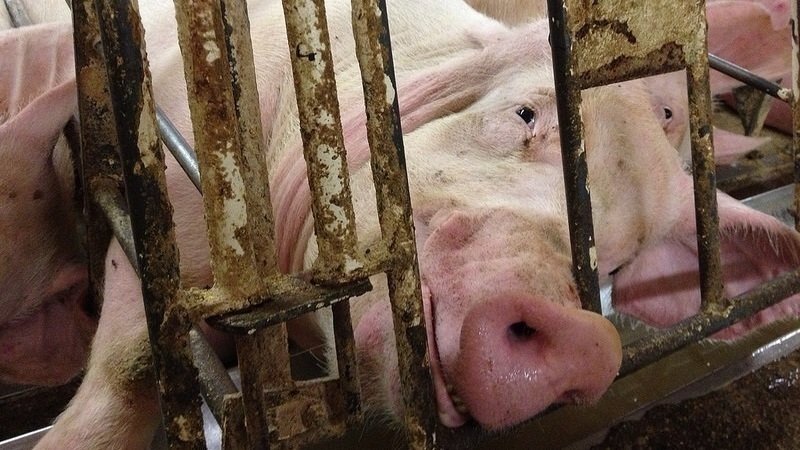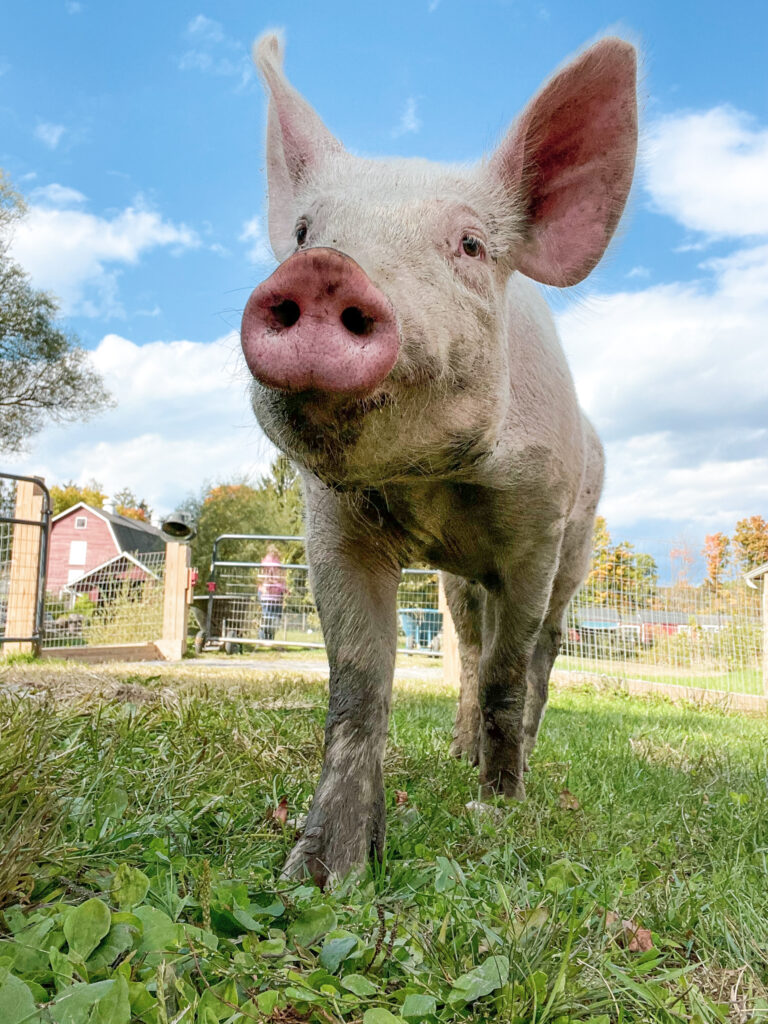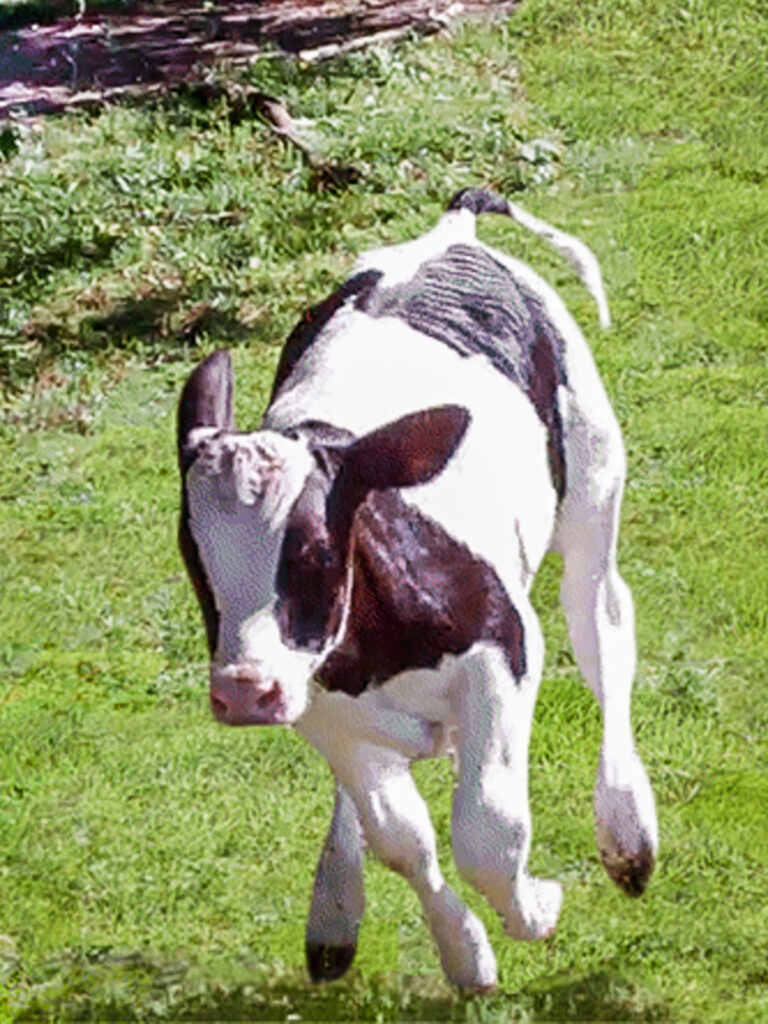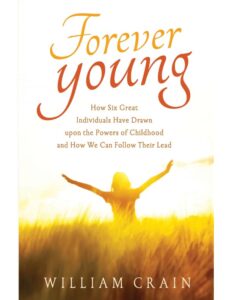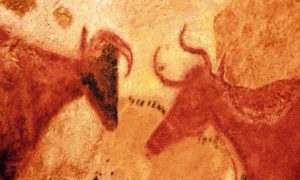Publications
By William Crain, Safe Haven’s Co-founder
March 3, 2024
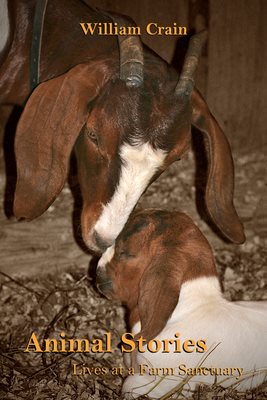 This book is a collection of short, easy-to-read, and moving stories about rescued farmed animals who have found a loving, lifelong home at Safe Haven Farm Sanctuary.
This book is a collection of short, easy-to-read, and moving stories about rescued farmed animals who have found a loving, lifelong home at Safe Haven Farm Sanctuary.
Click here to order the book on Amazon, or click here to order on the Harvard Book Store web site!
A few noteworthy comments in praise of the book:
“These moving stories will brighten your day and leave you filled with wonder.” Maya Gottfried, author of Good Dog, Vegan Love, and Our Farm
“The stories remind us of the sentience, intelligence, and mystery of nonhuman animals, touching something deep inside of our humanity.” Angela Crawford, co-author of The Behavioral Treatment Medicine Planner
A Mother is a Mother
By Heather Stark James, Safe Haven’s Social Media Specialist
July 18, 2023
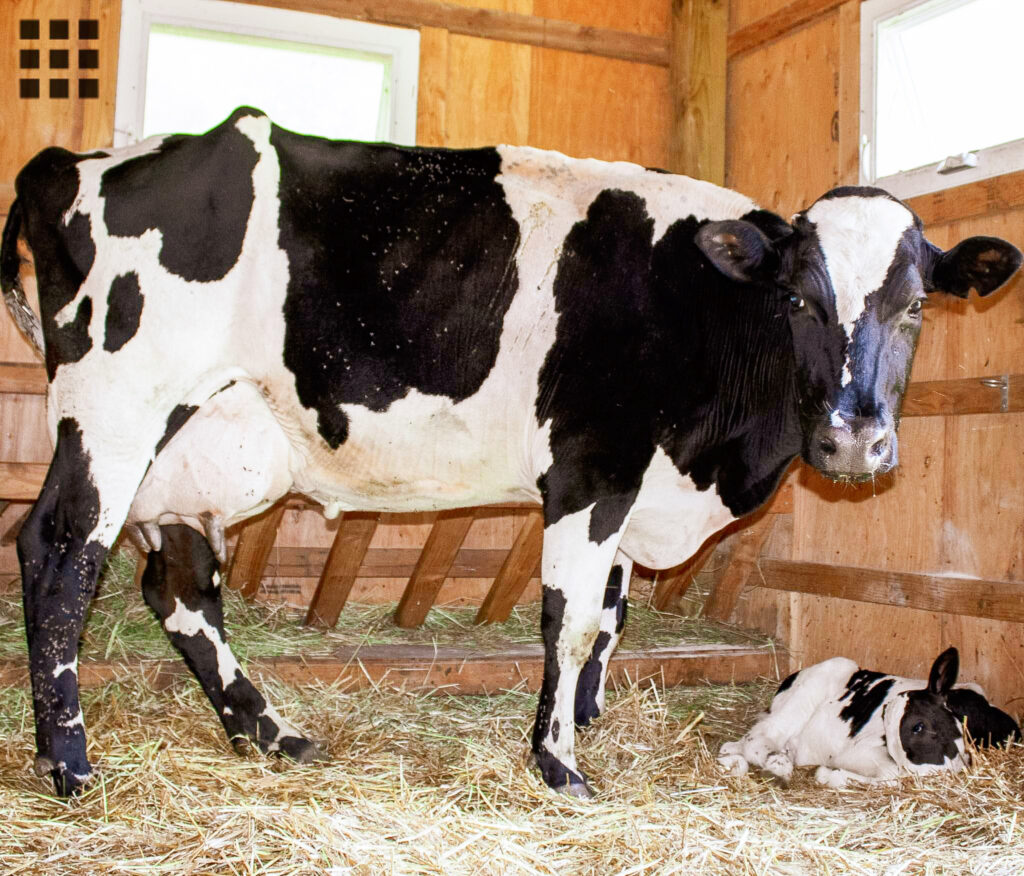 A little over a year ago I was shocked and thrilled to learn that Flo, a recently rescued cow was pregnant. I was overcome with joy that Flo would be able to safely and lovingly give birth and be able to keep her calf. If Flo was still on the dairy farm where she spent the first part of her life her baby would immediately be taken from her. I was also very happy to be pregnant at the same time as Flo, our children being born only three months apart.
A little over a year ago I was shocked and thrilled to learn that Flo, a recently rescued cow was pregnant. I was overcome with joy that Flo would be able to safely and lovingly give birth and be able to keep her calf. If Flo was still on the dairy farm where she spent the first part of her life her baby would immediately be taken from her. I was also very happy to be pregnant at the same time as Flo, our children being born only three months apart.
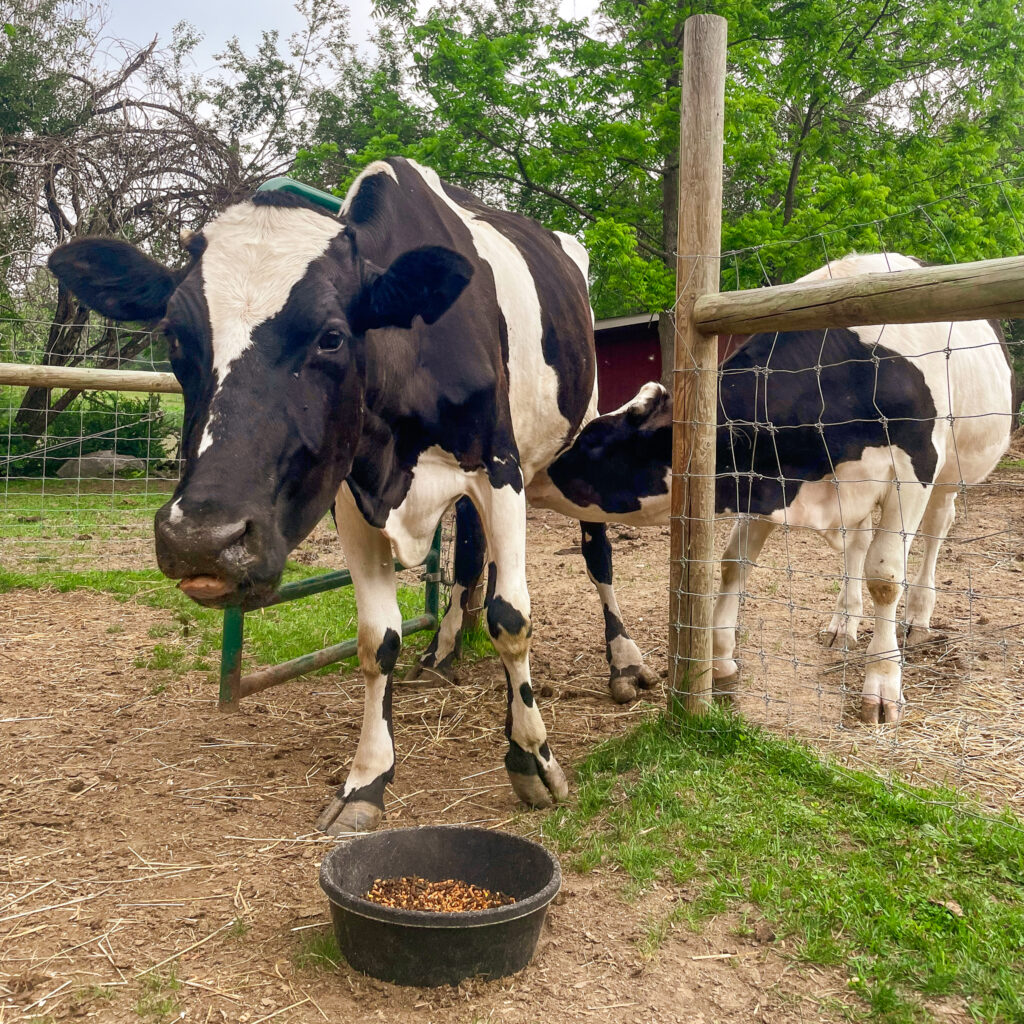 As a mother, I simply cannot fathom the unbearable pain and torment mother cows and their children endure within the dairy industry. I think it’s important to note that at the age of one, Cole is still nursing. He still needs nutrition and the feelings of comfort and security he gets from his mom. I have had the joy of nursing a baby just a few months younger than Cole alongside his incredible mama Flo and the bond she shares with her child is no different than the one I share with my own.
As a mother, I simply cannot fathom the unbearable pain and torment mother cows and their children endure within the dairy industry. I think it’s important to note that at the age of one, Cole is still nursing. He still needs nutrition and the feelings of comfort and security he gets from his mom. I have had the joy of nursing a baby just a few months younger than Cole alongside his incredible mama Flo and the bond she shares with her child is no different than the one I share with my own.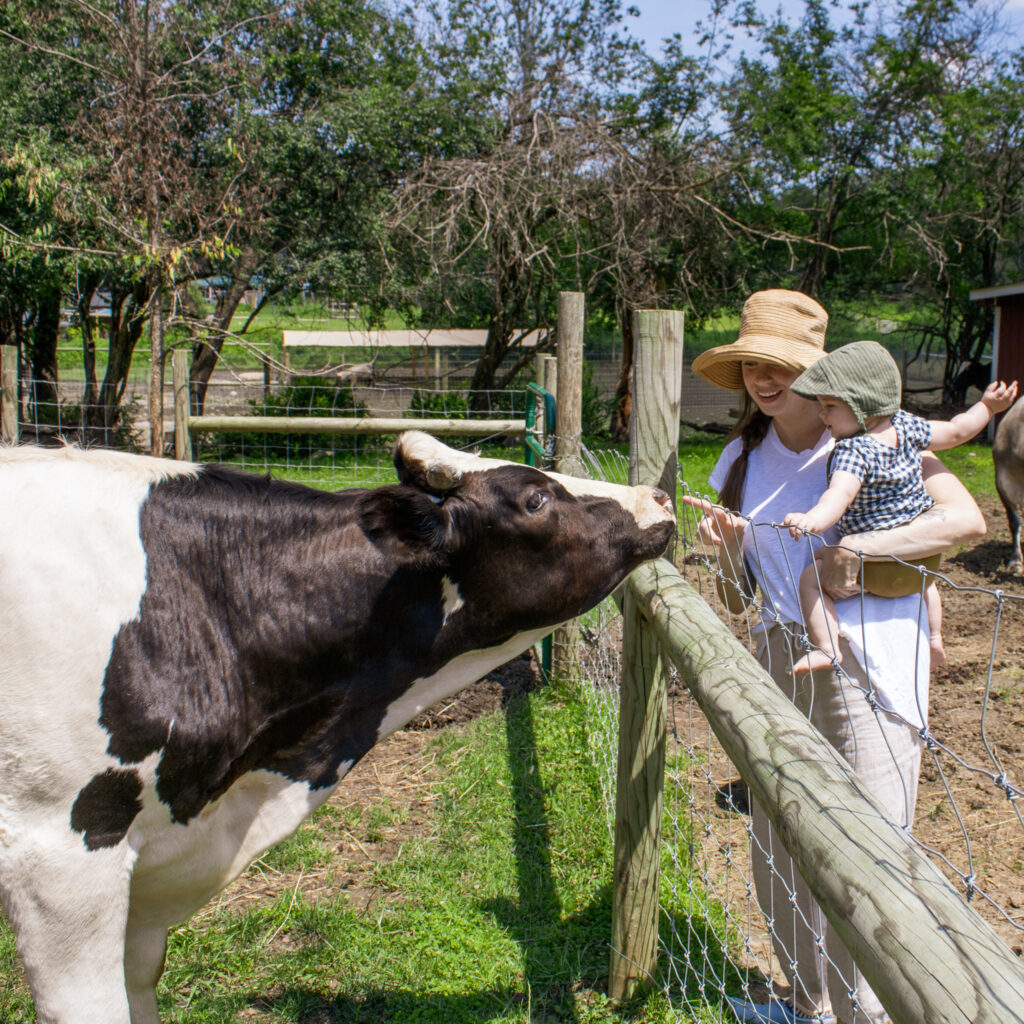 When my baby and baby Cole wake in the night feeling hungry or scared, Flo and I make the same instinctual choice, we support and comfort our children. When Flo and I see our children exploring and playing without a care in the world, Flo’s heart and mine sing. If someone or something threatens our babies safety, Flo and I would fight with an unparalleled strength to protect them.
When my baby and baby Cole wake in the night feeling hungry or scared, Flo and I make the same instinctual choice, we support and comfort our children. When Flo and I see our children exploring and playing without a care in the world, Flo’s heart and mine sing. If someone or something threatens our babies safety, Flo and I would fight with an unparalleled strength to protect them.A mother is a mother. And no mother should ever experience the heartache of their child being stripped from them, never to be seen again. I beseech you, please consider ditching dairy. There are so many alternatives available that won’t cause this unbelievably significant devastation.
Click here to learn more about the many delicious milk alternatives available today.
The Oasis of Love
By Harold Hovel, Safe Haven Board Member
October 11, 2022
 Something extraordinary happens when we visit a farm sanctuary, a haven of safety for lucky farm animals, usually rescued from slaughter or some other abuse. You realize when you go there that you’ve entered a different world, as if you pass through a gateway when you enter the sanctuary. It’s an amazing experience to have turkeys, goats, chickens, pigs, or others run up to you in an obviously happy, almost joyous greeting. The first time we visited the wonderful Safe Haven Farm Sanctuary in Poughquag, we were warmly greeted by 4 large turkeys that came running to us, anxious to greet the new humans.
Something extraordinary happens when we visit a farm sanctuary, a haven of safety for lucky farm animals, usually rescued from slaughter or some other abuse. You realize when you go there that you’ve entered a different world, as if you pass through a gateway when you enter the sanctuary. It’s an amazing experience to have turkeys, goats, chickens, pigs, or others run up to you in an obviously happy, almost joyous greeting. The first time we visited the wonderful Safe Haven Farm Sanctuary in Poughquag, we were warmly greeted by 4 large turkeys that came running to us, anxious to greet the new humans.
But it was another time that I will always remember. I was walking outside and saw a goat in the distance. I had never met a goat before so I started walking toward her, and she started walking toward me. When we reached each other, I started patting her head and neck, and then an amazing thing happened. She didn’t know me; I could have been an abuser, but she leaned against me and rested her head in my lap. She gave me the gift of unconditional love, perhaps unconditional trust, or both, and in that moment, though we had only known each other for 5 minutes, there is no doubt in my mind that we loved and trusted each other completely. Her name was Violet, and I’ll never forget that encounter as long as I live.
On the side of the gateway we all live on, there is a sea of misery. There are nearly 10 billion farm animals killed in the US each year: 9 billion chickens, 225 million turkeys, 36 million cows, 124 million pigs, millions of ducks, goats, rabbits, sheep, calves, and horses. Every one of them lives in fear and despair all their lives, with terror and suffering as their fate when they are killed so humans can eat their flesh.
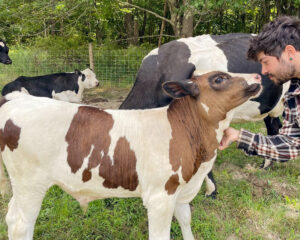 When you pass through the gateway into a sanctuary, you enter an oasis of love. There, the farm animals only receive love and caring from the human beings they encounter every day.
When you pass through the gateway into a sanctuary, you enter an oasis of love. There, the farm animals only receive love and caring from the human beings they encounter every day.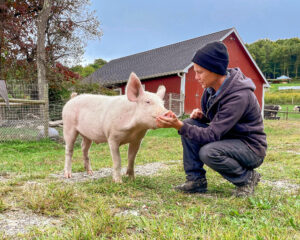 When they are born in the sanctuary (some rescued animals turn out to be pregnant), they only know love from the first day of their lives. If they come to the sanctuary from a life of abuse, they learn, perhaps slowly but eventually, that they are loved, respected, and will always be cared for.
When they are born in the sanctuary (some rescued animals turn out to be pregnant), they only know love from the first day of their lives. If they come to the sanctuary from a life of abuse, they learn, perhaps slowly but eventually, that they are loved, respected, and will always be cared for.The contrast with the joyous, loving faces of the animals at the sanctuary is dramatic. There is no fear, no despair, only unconditional love and unconditional trust. The contrast between a calf or pig, frolicking in joy in a field vs. being confined to a crate for their short, miserable lives, couldn’t be greater.
Cole the calf and Caleb the pig are living without fear of the humans they meet and they express love in return in their own special way. I urge you to visit one of these magical places, a place where speciesism doesn’t exist and animals live without fear of the humans they meet and they express love in return in their own special way.
Pandemic Pets’ Are Surrendered in Droves as the World Reopens
By Sarah Maslin Nir
Published in the NY Times on Oct. 1, 2022
In recent weeks, so many people have called Bill Crain’s Hudson Valley farm rescue to surrender their ducks and chickens — many purchased at the height of the pandemic lockdown — that he finally marched into a local farm store and demanded to speak to a manager. His plea: Stop selling chicks and ducklings. “They think the pandemic is over, and they don’t want to devote time to taking care of them anymore,” Mr. Crain, 78, said in an interview from his Safe Haven Farm Sanctuary in Poughquag, where he said there are now so many calls from people hoping to give up their pets that he must turn birds away — his coops are full.
“It’s a crisis that people are abandoning these animals,” he said. One of the slim silver linings of the pandemic’s earliest days was the addition of animals to many families. Some people, decamping from virus-besieged cities for the countryside, stoked a craze for backyard fowl. There was an emptying of animal shelters as people stuck at home found unexpected room in their lives for cats and dogs. Socially distant and lonely, or with kids to entertain, many cleared pet store shelves of gerbils and lizards, chinchillas and snakes.
Gloomy prognostications of a swift, post-pandemic boomerang of dogs and cats back to shelters do not appear to be bearing out. But as the world rights itself — workers back in offices, students back in school — other sorts of pets are apparently not so lucky. Those who rescue and advocate for smaller animals fear that they are seeing the beginning of a tide of reptiles, birds and rodents — even some fish — given up by once enthusiastic families.
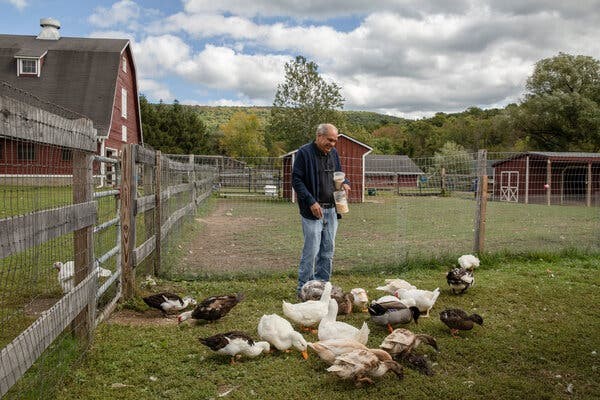
Bill Crain, who runs the Safe Haven Farm Sanctuary in Poughquag, N.Y, with his wife Ellen, has had to turn away people hoping to surrender their ducks and chickens. Small animal surrenders spiked by more than 50 percent nationwide in the first six months of 2022, compared to the same period the year before, according to Shelter Animals Count, which collects data from more than 6,000 shelters, though they still remain about 20 percent lower than prepandemic.
Click here to watch the Spectrum News interview with Bill Crain as he shares how the sanctuary was affected in 2022 by the uptick in requests to take animals that were adopted during the pandemic.
In contrast, surrenders of cats and dogs have climbed less than 7 percent over the year before, and are still about 15 percent below 2019 levels.
In New York City, so many guinea pigs have flooded the city’s animal shelter system — 600 so far this year, more than double prepandemic numbers — that the City Council is considering a bill that would ban their sale in pet shops. Most are under three years old, indicating they were pandemic purchases, said Katy Hansen, a spokeswoman for the city’s shelter system, Animal Care Centers of New York City. The population spike has forced the shelters to invest in a new $20,000 guinea pig tower, where the animals live stacked in sliding trays.
On Wednesday, a box containing 22 guinea pigs of all ages was found abandoned in the lobby of a Staten Island apartment building, Ms. Hansen said. “This situation has become untenable,” she said. “We are at our wits end.” There are other, less quantifiable warnings: Some city pet store owners say that customers who at the height of the pandemic scooped up creatures like bearded dragon lizards, and hamsters as playmates for cooped-up children have brought them back. People who foster guinea pigs in New York say they are overrun. In Central Park, rescues of domestic red-eared slider turtles nearly tripled to 29 this year so far — though the parks department cautioned that the numbers could mean more sightings of distressed turtles, not more animals. Rabbits and guinea pigs have also been found. It is illegal to release animals in city parks.
A constellation of factors is apparently driving the surge. Christa Chadwick, the vice president of shelter services at the American Society for the Prevention of Cruelty to Animals, suggested that part of the uptick may be because many shelters were not taking in animals over the course of the pandemic. And, she noted, shelters are glutted with small animals in part because adoptions overall have slowed. “It’s important for the public to come back in droves to shelters,” she said. “Whether it is for cats or dogs or chickens or hamsters.”
Rising rents, inflation and housing insecurity have also forced people to make difficult decisions about keeping even beloved pets, said Hilary Hager, vice president of outreach, engagement and training at the Humane Society of the United States. “I would never want to suggest to anyone that people don’t care,” Ms. Hager said. “There are just a lot of other factors that are coming into play.”
Jade Perez’s family acquired a dog and two kittens to stave off the loneliness of lockdown, she said. But when rising rents forced her family to downsize to a smaller Staten Island apartment, she put Honey, the guinea pig she had bought just before the pandemic, up for adoption on Craigslist. “We have a lot of animals, and we just can’t take care of the guinea pig now,” said Jade, who is 17, citing inflation’s toll on the prices of food and supplies. “He’s not living the best life he can.”
The Importance of Mothers
By Bill Crain
A sentience article from All-creatures.org posted Februrary, 2022
Most of the chickens and ducks we have adopted have been motherless. But a few have had mothers, and these babies have shown us what the others have missed.
Every spring our farm sanctuary receives one or two calls a day from people who would like us to adopt their young chickens or ducks. They usually purchased the animals from a farm supply store like Tractor Supply. The babies looked so cute peeping away under heat lamps, the customers couldn’t resist taking them home. But they discovered that caring for the animals was more trouble than they anticipated.
In June, we also receive several calls — about twice a week — from schoolteachers. They explain that they ordered fertilized eggs from a company to show their children about hatching and development. The children watched over the eggs and babies, keeping them warm under heat lamps. But now the school year is ending, and the teachers cannot find the hatchlings permanent homes. The teachers, like the other callers, hope we can take them in.
But our sanctuary is typically filled to the brim with chickens and ducks. We rarely have room for more. Other sanctuaries are usually at full capacity, too. We give people ideas for finding homes, but frequently the chicks and ducklings are simply abandoned. People tell us that they have seen them on the roadsides and in woods.
Our sanctuary, working with Dr. Karen Davis of United Poultry Concerns, is trying to make the public aware of the fate of so many of these young animals.
Inspired by a concern raised by Dr. Davis, our sanctuary also encourages people to recognize that the babies are growing up without mothers. Most of the chickens and ducks we have adopted have been motherless. But a few have had mothers, and these babies have shown us what the others have missed.
For one thing, mothers provide warmth and comfort. Heat lamps can keep babies warm, but they cannot provide the full comfort a baby receives when nestled under a mother’s feathers. True, motherless chicks and ducklings huddle together, but they are too small to substitute for a mother’s body.
In addition, mothers offer protection. When a baby dives underneath a mother’s feathers, the baby hides from threats in his or her surroundings. A baby under a heat lamp is always exposed.
As babies grow, mothers protect them by making sure they don’t roam too far. This was clearly demonstrated on our farm by a chicken whose daughter was congenitally lame and unusually small. The mother always kept her tiny child very close by. When she felt the youngster had wandered too far, she rushed over, gave her child a peck, and nudged her back.
In the barn, the mother’s actions kept her child from venturing into areas where a turkey or goat might inadvertently step on her. Outdoors, the hen’s behavior prevented the youngster from going too far to get back in case a predator appeared.
Animal researchers have found that chicken hens display an innate rescuing instinct, and we also have seen this on our farm. When a chick has fallen or got stuck in a bush, the chick has emitted a high-pitch distress call that prompted the hen to rush to the baby’s aid. Our motherless chicks are more helpless. They are more alone in the world.
Teachers want students to learn about animal birth and growth. This is a great goal, but students can only learn so much from motherless babies. They don’t learn how babies hide in their mother’s feathers, how mothers keep their babies nearby, or how mothers rescue them.
Although a farm sanctuary offers many opportunities to learn about animal behavior, the ideal setting is a species’ natural environment — the wild. On our farm, the setting that is the most open and wild is our large pond. Among the animals there, the most visible are mallard ducks, and I have spent hours watching them.
On several occasions, I saw a mother lead her babies to a shore where they energetically pecked for food. They acted like they were starving. But sometimes, for reasons unknown to me, the mother suddenly went into the water and began to swim away. Every time, the ducklings stopped foraging and followed her into the pond. They obviously wanted to eat, but the urge to follow their mother was stronger. If we were able to hold a conversation with them, I’m sure they would tell us, “Nothing is more important than my mother.”
Sanctuary Co-founder Bill Crain invites us to celebrate and rediscover the restorative power of childhood.
In his book, Forever Young: How Six Great Individuals Have Drawn upon the Powers of Childhood and How We Can Follow Their Lead, Bill focuses on Henry David Thoreau, Albert Einstein, Charlotte Bronte, Howard Thurman, Jane Goodall, and Rachel Carson. He explores how these impactful individuals were able to restore their spirits and nurture their creativity: Click here if you’d like to discover how each revived childhood qualities such as a sense of wonder, playfulness and a feeling for nature, and in the process overcame personal roadblocks and expanded our understanding of the world.
How I found peace with the animals – and perhaps how stone-age man did too
By Bill Crain
The Story of Three Chickens
By Bill Crain
Initially posted on On All-Creatures website, August, 2019
https://www.all-creatures.org/stories/a-three-chickens.html
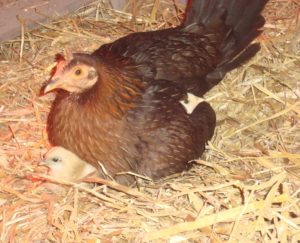
One day my wife, Ellen, greeted me with the words, “Congratulations, you’re a new grandfather.” I was puzzled until she explained that one of our chickens, a smallish hen we called Chicken Little, had hidden two eggs that had hatched. My new “grandchildren” were two chicks. Our staff named them Charlotte and Chuck.
Many of the chickens on our farm sanctuary have escaped from factory farms or slaughter houses. Others have come from homes in which the owners could no longer care for them. Chicken Little came with a group of hens who had lived a very different life.
These hens had been roosting in trees outside a small town in rural New Jersey. The trees overlooked a camp established by homeless people, who tossed the chickens some of their food. But the town officials drove the homeless away. Two animal rescuers worried about the welfare of the chickens without the food from the homeless. So the rescuers captured as many as they could–Chicken Little and seven other hens–and brought them to our sanctuary.
The hens, whom we called The Jersey Girls, weren’t like our others. The Jersey Girls were much warier of us. They also were slim and athletic. They could fly to the top of tall trees and dart through the air at high speeds.
Chicken Little soon demonstrated her independence. Instead of spending nights in her coop, she took up residence in our back barn. That is where Chuck and Charlotte were born.
Chuck grew into a large, handsome rooster. Charlotte, however, was born with a deformed leg and barely grew at all. But she was spunky. She hopped energetically about, exploring pastures with the other chickens. And when other chickens came near her food, she pushed them away. All the humans on our farm admired and adored her.
As an adult, Chuck kept on eye on the whereabouts of Chicken Little and Charlotte. When, after two years, Chicken Little died, Chuck watched over three other hens as well. With the chivalry of a true rooster, Chuck made sure the hens ate before he did. He and Charlotte also took a friendly interest in Violet, a very old dwarf Nigerian goat who slept next to them.
At the age of five years, Charlotte began to weaken and spend more time resting in the barn. Then one morning, Edwin, one of our staff members, discovered Charlotte lying motionless. Next to her was Violet, curled around Charlotte in an awkward position. Edwin asked two other staff members, Joy and Donna, to look at Charlotte, and they confirmed Edwin’s fear that she had died.
Violet’s unusual position, curled next to Charlotte, puzzled our staff. It occurred to them that Violet might have moved next to Charlotte to provide comfort or protection.
Donna and Joy wrapped Charlotte in a blanket and took her into the cottage until a grave could be dug. But when Donna returned to the barn, she saw that Chuck had entered while she was away, and Chuck was very upset. He was standing behind a bale of shavings and staring at the wall.
Donna wondered if Chuck might need to see that Charlotte had died and mentally process this fact. So Donna brought Charlotte’s body back into the barn. Chuck then walked out of the corner and looked at Charlotte’s body for at least 15 minutes. Finally he crowed and walked away. He then acted normally, and has done so ever since.
Chuck’s reactions call to mind another death, several years earlier. When Katie, a very caring hen, was dying, the hens, partridges, and bantam rooster in her aviary stood next to her. When Katie actually died, the bantam rooster crowed and walked away.
Chuck’s behavior was similar, and it adds to growing observations that nonhuman animals sometimes need to spend time watching over the recently deceased. They need, that is, to engage in the kinds of wakes and vigils that are part of human rituals.
Farm Animals Mourn the Loss of a Special Turkey
By Bill Crain, cofounder of Safe Haven Farm Sanctuary
Published June 2019 on Pawling Public Radio
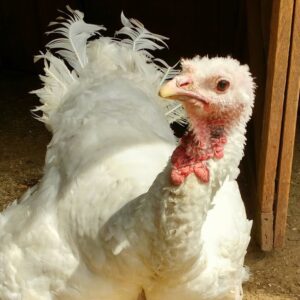
Emma, one of our turkeys, recently died. She was approaching the age of 11 years. This is very old for a domestic turkey; their natural lifespan is typically 2 to 6 years. I would like to tell you about Emma’s life and then describe our animals’ unexpected reactions to her death.
Emma came to our farm sanctuary with three other baby turkeys, all females. They were dropped off anonymously, so we had no background information. But we guessed that they began life on a factory farm because their feathers were all white. Factory farms breed turkeys to be all-white to prevent coloring of the meat.
In addition, the sharp ends of their beaks and toes had been cut off. Factory farms perform these amputations because the farms’ overcrowded conditions can cause fighting. Without sharp beaks and toes, the turkeys are less likely to harm one another and damage the owners’ products.
The young turkeys slept in our main barn at night and enthusiastically explored the farm during the day. They often traveled together and behaved in similar ways, but they also revealed unique personalities. Emma was exceptionally loving toward humans. She frequently approached us and sat quietly while we patted her.
Occasionally another turkey became angry at a human and pecked the person. Whenever Emma saw this, she pecked the turkey, seeming to say, “Stop that! Be nice!”
As the years passed, Emma’s three original friends died, all at about 6 years of age. New turkeys came, and Emma was friendly with them all.
In her last two years, Emma developed health problems. Her eyesight weakened and she experienced respiratory difficulties. She also developed arthritis in her legs, which restricted her mobility. All the humans on our farm were so devoted to Emma that they constantly looked for ways to improve her health and comfort.
One day our oldest goat, Basil, demonstrated her own concern for Emma. Emma was eating out of her bowl in her personal area when Gracie, a pig who had recently joined our farm, rambled over and started to eat some of Emma’s food. Seeing this, Basil rushed to the scene and butted Gracie away. Emma then finished her meal in peace.
Emma’s respiratory problems gradually worsened, and suddenly she could barely breathe. In desperation, my wife, Ellen, and I drove her to the vet, but he couldn’t save her. We drove her body back to our farm, buried her in our backyard, and gathered the staff for a tearful ceremony.
That evening, I went into Emma’s barn as part of my routine bed check. (I see if the animals are comfortable and make sure all doors are securely shut against possible predators.) When I walked inside, our four other turkeys were squawking loudly. Without thinking, I said in a sad tone, “Emma died.” They suddenly fell silent, and they were still quiet when I checked an hour later.
What had transpired? This may sound farfetched, but here is my guess. The turkeys were squawking because they were upset about Emma’s absence. They wanted to know what happened to her. Then they understood from my tone of voice that Emma had passed away, and they became sad and subdued.
The next morning Joy, our head caretaker, also had an unusual experience. When Joy went to let the goats out of their stalls, Boomer, the goat who slept nearest to Emma, didn’t get up. When Joy knelt beside him to see what might be wrong, he nuzzled his head against hers. She patted him a couple minutes, and he then rose to his feet and went outdoors. Joy felt that Boomer simply wanted to be comforted.
Other staff members independently told me that the day after Emma’s death was unusual. All the animals—the turkeys, goats, chickens, sheep, pigs, and others—were exceptionally quiet and gentle. After losing Emma, no one was in a mood to quarrel.
Safe Haven’s co-founder called “The O.G. of Animal Activism”
 Bill Crain is featured in Dirt Magazine’s inspiring article giving true insight into Bill’s recent experience in jail for civil disobedience and his continued motivation and devotion to help farm animals and stop the inhumane practice of bear hunting.
Bill Crain is featured in Dirt Magazine’s inspiring article giving true insight into Bill’s recent experience in jail for civil disobedience and his continued motivation and devotion to help farm animals and stop the inhumane practice of bear hunting.
Milo the goat defends his mother Bessie!
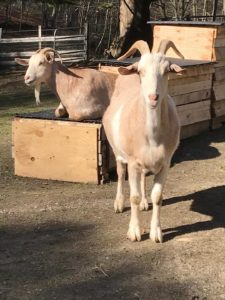 Check out this recent Poughkeepsie Journal article written by Bill Crain, co-founder of Safe Haven. The story features our mother and son rescue goats, Bessie and Milo (standing), and describes how Milo defends and protects his mother from a dominant goat.
Check out this recent Poughkeepsie Journal article written by Bill Crain, co-founder of Safe Haven. The story features our mother and son rescue goats, Bessie and Milo (standing), and describes how Milo defends and protects his mother from a dominant goat.
Click here to read full story.
Saving the Chickens from Crossing the Road
This article appeared on the Ethical Culture Fieldston School web site on November 19, 2018.
Link to article on ECFS web site.
By Courtnay Hull, Middle School Science Dept Chair
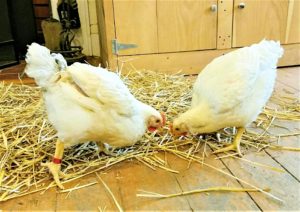
A couple weeks ago, two stray chickens were spotted wandering not far from the Fieldston campus. The situation was brought to our attention and, with the assistance of members from the facilities department, the chickens were collected. Immediately, I reached out to numerous rescue organizations and then worked with students and the dining staff to obtain food and set-up a temporary shelter. Shortly after their rescue, Felix and Adler — named after the school’s founder — began happily to cluck, eat, and clean themselves.
In less than 24 hours, the Safe Haven Farm Sanctuary in Poughquag, NY, agreed to take our two feathered friends. Liz Holub — parent of children in 7th grade, 10th grade, and 12th grade — kindly drove the chickens up to their forever home in the scenic Hudson Valley.
There’s one other lovely aspect to this story. Just as the Fieldston community worked together to save Felix and Adler, the chickens’ new home was with a former Fieldston family. Yes, the founders of the sanctuary, Ellen and William Crain, sent their son to Fieldston years ago!
The Animals Are Like Us
This article appeared in the New York Times on July 12, 2018
To the Editor: Re “At Harvard, Doctors Go Wild” (Science Times, July 3), about a clinical elective course for medical students intended to show the interdependence of animals and humans:
In 2008, after 31 years as a pediatrician, I co-founded a farm sanctuary that provides a lifelong home to farm animals rescued from slaughter and abuse.
Our animals frequently require veterinary treatment, and like the Harvard medical students, I became increasingly impressed by the similarities between the anatomy and illnesses of human and nonhuman patients. I also saw that each nonhuman patient, like each of us, reacts to treatment in an individual way.
The medical students are ultimately interested in improving human health. I would add that a recognition of the similarities between human and nonhuman patients can have a wider impact. If we see that other living beings have much in common with us, we are more likely to treat them with compassion and respect.
ELLEN F. CRAIN, POUGHQUAG, N.Y.
Rooster’s death-defying feat serves as example to us all
This article appeared in the Poughkeepsie Journal on August 18, 2017
Link to article in Poughkeepsie Journal.
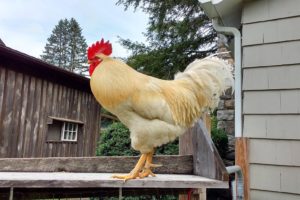
This is the story of a rooster named Bogie. Bogie began life in a middle school hatching project. A teacher had ordered six fertilized eggs from a company to show students how chickens hatch and grow. But the teacher hadn’t thought about what to do with the chicks when the school year ended.
One possibility was to return them to the company, but the company was likely to slaughter them. Fortunately, a parent got in touch with an animal lover who contacted our farm animal sanctuary, and we adopted the chicks.
Although these chicks were lucky, many chicks raised in school hatching projects are destined to have an unhappy ending. The schools are often unable to find anyone willing to assume responsibility for caring for the chicks throughout their lifetime. It is vital that schools plan ahead. Before placing orders for eggs, they should make sure they can provide the chicks with permanent and loving homes.
Our staff decided to name this group of chicks after classic movie stars, such as Marilyn for Marilyn Monroe. This young rooster was named Bogie after Humphrey Bogart.
When the staff named him Bogie, they didn’t think of him as a tough guy like the characters played by his namesake. But as the little rooster’s personality developed, he lived up to his name. He took a bold stand in disputes with other roosters and liked to fly on top of a fence and crow, as if announcing his importance. Sometimes he flew over the fence in order to explore the surroundings, and we had to guide him back into his fenced area.
Then one day, before we could guide him back, he was suddenly gone. All we saw were piles of his white feathers on the ground and scratches in the dirt, signs of a struggle. Bogie had been snatched by a predator, probably a hawk.
With heavy hearts, we put the other animals to bed and went to our own houses for the night. Later that evening, as rain came down, Bill (co-author) performed the routine bed check to make sure all the animals were securely inside their enclosures. As he looked around, he half expected to see Bogie, but Bogie was gone.
Then something incredible happened. When we went to the barn the next morning to feed our animals breakfast and let them out for the day, there was Bogie standing outside the barn, waiting for us! He was missing several feathers, but he was alive and well. He had somehow escaped the clutches of the predator and hid all night before returning home. We were overjoyed.
Bogie’s experience showed us that we had to take further precautions against predators, so we added netting and wire to several open areas. Bogie also demonstrated that he is tougher than we had ever imagined. He can serve as example that all of us may be capable of far more than we realize.
Donna Scott is a staff member at Safe Haven Farm Sanctuary, Bogie’s home. Bill Crain is the sanctuary’s cofounder.
Hebrew name ‘Chava’ fitting name for rescued hen with zest for life
Bill Crain, Poughkeepsie Journal June 28, 2018
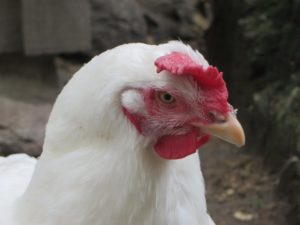
This past winter seemed to go on forever. Whenever we thought a snowstorm was the last one, a new storm arrived. The snowfall was especially heavy at our farm sanctuary, which is on top of a hill. But the birds pushed forward with their spring behavior. Even when the air was freezing and the ground was covered with snow, the songbirds sang and the woodpeckers hammered on the trees. The ducks at our pond mated, and the females went up the hillsides to nest. The weather didn’t deter them.
The birds’ determination made me think of one of our sanctuary’s animals, a hen named Chava (pronounced “Hava”). Chava was rescued by a rabbi in Brooklyn. He was walking along a busy street when he saw a small hen being carried to a nearby slaughterhouse. He purchased the hen and announced to everyone in the vicinity that he was saving the hen’s life because all life is sacred. In fact, the name he gave her means “life” in Hebrew. One of the rabbi’s friends, a young woman who loves animals, called us and we agreed to adopt the hen.
For two years, Chava lived happily with the other chickens at our sanctuary. She enjoyed foraging in the grass and taking dust baths in the dirt. On nice days, she liked to sit and bask in the sunshine. Then one day, Chris, a young man who works at our sanctuary, noticed that Chava was unusually quiet. Chris took her into the cottage and placed her on our medical examining table, where he detected a foul odor. He called our chief caregiver, Joy, who lifted Chava’s wings and saw a huge cut on her abdomen. Some flesh had died, causing the odor. No one knew how Chava received the wound. All the staff wished they had noticed it earlier. I rushed Chava to the vet. He told me she was so badly injured that she probably wouldn’t survive. He suggested I consider euthanasia. I said our sanctuary was filled with animals who had somehow escaped death, and I wanted to give her the chance. So I took her back to our sanctuary.
Adhering to the vet’s instructions, we kept Chava in a large crate in our cottage. We soaked her wound, applied antibiotic cream and changed her dressing every day. She was in surprisingly good spirits. But when we took her to the vet for a two-week follow-up visit, he returned from his procedure room looking sad. Her wound couldn’t heal, he said, because the dead tissue was stuck to it. We were heartbroken. Suddenly, his assistant appeared and said, “Doctor, would you please come back to the procedure room with me?” When they returned, they were beaming. The assistant had noticed a tiny spot where the dead tissue might be peeling off. The vet then discovered that a good amount of it was loosening. Chava was healing herself! The vet sent us home to continue Chava’s treatments. After four months she completely recovered.
Chava has had other setbacks. She acquired a sinus problem which, despite months of treatment, still lingers somewhat. But it hasn’t slowed her down. She actively forages for food and runs in the grass.
Chava is now 6 years old (which is pretty old for a domestic chicken), and she also suffers from arthritis. It’s so bad in one leg that she can barely put weight on it. But she keeps on moving. She hurls herself forward and hops on her good leg, sometimes flapping a wing for extra speed.
Chava exemplifies a life force that won’t be denied.
Link to article in Poughkeepsie Journal.
Young goat’s antics uplift farm workers
This article appeared in the Poughkeepsie Journal on June 3, 2017
Link to article in Poughkeepsie Journal.
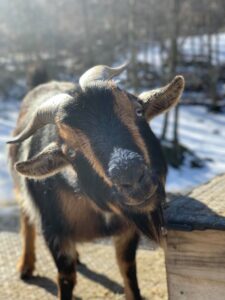
Late one night in November, our farm animal sanctuary received a phone call from a police officer in the Bronx. He asked if we would adopt a small male goat being held in his precinct.
The officer explained that he and his colleagues had been sitting around the precinct that night, mourning the fatal shooting of a fellow officer, when a resident brought in the goat. The goat had been roaming the streets.
The officer said he loved animals and worried that if the goat went to a city shelter he might be euthanized. The officer added that after the death of his colleague, he couldn’t stand the thought of more dying. We agreed to adopt the goat, and the officer and a partner drove him to us early in the morning.
When the goat arrived, we saw he was just a baby and of the Nigerian Dwarf breed. He was thin and frightened, and his head and horns were covered with wax, suggesting to the officers that he might had escaped a ritual slaughter. Our vet immediately came over and told us the goat was anemic and had pneumonia.
Despite his fears and ailments, the little goat began to show signs of a lively curiosity, and everyone who works on our farm quickly fell in love with him. We named him Cesar in honor of a cheerful construction worker who has made numerous repairs on our farm.
Cesar soon recovered from his illnesses, and he is one of the most adventurous and fun-loving animals on our farm. He goes everywhere. He leaps over stall gates, climbs stairs and jumps on any structure that will take him to new places. We never know where we might find him.
My wife, Ellen, who co-founded our farm sanctuary with me, told me about the following strange event.
One morning, Chris, one of our staff members, came over to Ellen and asked, “Why is the ceiling fan in the back barn running?” Ellen said she didn’t know. After all, it was a bitterly cold winter day — much too cold for the fan to be on. So Chris turned it off.
Later that day, Ellen heard the fan running again. Puzzled, she entered the barn. There she saw Cesar, high up on a narrow ledge, pulling the fan’s cord with his teeth. He was actually varying the fan’s speeds. She knew that getting him down would require some effort, but she found the sight hilarious.
Farm work can be tiring. But when we feel a bit worn down, Cesar’s amusing antics often cheer us up.
Animals find “safe haven” on couple’s farm sanctuary
This article appeared in the Poughkeepsie Journal on March 22, 2017
Here is an excerpt from the article.
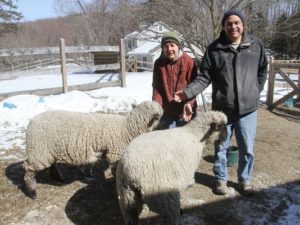
When Maddie, a goat who lives at the Safe Haven Farm Sanctuary in Poughquag, laid her head on Bill Crain’s lap, he knew he had made a difference.
“Every time she saw a human it meant possible death,” said Crain, co-owner of the Sanctuary with his wife Ellen. “It took a long time, but it was one of the greatest moments for me. She finally trusted me.”
It’s exactly the kind of feel-good moment that Crain was going for ever since he and his wife decided to open Safe Haven.
Their desire to rescue farm animals came while the couple, living in Manhattan at the time, drove by a live meat market — otherwise known as a slaughterhouse — and saw two goats peeking their heads out.
“I thought that if I ever had a farm sanctuary, I was going to get those goats out of there,” said Crain, a professor of psychology at The City College of New York.
According to the Humane Society, approximately 9 billion cattle, chickens, ducks, hogs, sheep, lamb and turkeys are slaughtered every year. The Crains wanted to do their part to save the animals, so in 2006, they purchased a 40-acre farm in Poughquag that came with a barn and two houses.
Continue reading PDF version
Link to original article in Poughkeepsie Journal
Farm sanctuary welcomes potbellied pig
This article appeared in the Poughkeepsie Journal on May 12, 2016
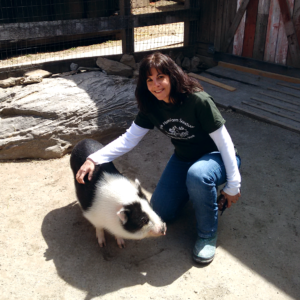
Recently a man from New York City called to ask if our farm sanctuary would adopt his family’s young potbellied pig. Potbellied pigs are related to the standard breeds but are smaller. The man explained that his family had purchased the pig, a male, as a pet. The family and the pig soon became very attached to each other. But the family had to leave him alone during the day, and he often cried. His cries disturbed the neighbors, who complained to the landlord. The landlord found out that New York City forbids residents to keep pigs, and the landlord gave the family two weeks to get rid of him.
The family felt terrible. They didn’t want to send the pig to a shelter, where he probably would be euthanized, but they couldn’t find him a new home. As the landlord’s deadline approached, the family thought they had found someone to take care of him, but the prospect fell through. The family contacted us and told us their plight. Our farm wasn’t set up to care for a pig, but the situation was so urgent that we said we would adopt him. All our staff members adored him, and he liked everyone. When people gave him a pat on the back, he rolled over for a belly rub. The word soon spread in the community that there was a cute little pig at our farm, and visitors poured in. The family had name him Oreo because of his black-and-white coloring, but they said we certainly could rename him. We wanted to name him after someone great and decided on Leo, after Leo Tolstoy, the Russian writer, pacifist and vegetarian.
Although Leo is widely adored, he also gets into considerable mischief. He sneaks into chickens’ aviaries and eats their food. He knocks over garbage cans in search of scraps. He crawls under gates and scampers around so vigorously that he frightens the turkeys and sheep. Staff members must constantly keep on the lookout for him. If Leo is not in sight, it’s a good bet he’s causing trouble. The staff members do their best to control Leo’s behavior, but it’s difficult. If, for example, he’s in an aviary eating chickens’ food, it’s difficult to get him to leave. The staff try to shoo him out, but he ignores them. Occasionally a staff member resorts to picking him up and carrying him out, and he squeals loudly in anger. We have had a few troublesome animals like Leo on our farm, and I have noticed that these animals soon respond surprisingly well to one or two particular individuals. In every case, the individual is exceptionally devoted to the animal. For Leo, this person is Donna Scott. Whenever Donna calls, Leo comes to her. Even if he’s eating other animals’ food, he stops and runs to her.
I asked Donna, “How did you accomplish this?” She said, “When I see Leo, little hearts pop out of my head. I give Leo lots of rewards. Sometimes the reward is a small treat like a raisin, but most often the reward is just some form of affection. I always pet him or brush him when he responds to my call. I believe Leo can sense my love for him. I think all living beings respond to love.”
Link to original article in Poughkeepsie Journal
Bantam rooster reveals unexpected side of personality
This article appeared in the Poughkeepsie Journal on May 16, 2015
Here is an excerpt from the article.
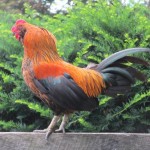 My wife, Ellen, and I founded Safe Haven Farm Sanctuary to provide a home for farm animals rescued from slaughter, neglect and abuse. In the process of caring for the animals, we have learned many new things about them. One animal in particular — our little Bantam rooster — taught us there can be much more to an animal’s personality than first meets the eye.
My wife, Ellen, and I founded Safe Haven Farm Sanctuary to provide a home for farm animals rescued from slaughter, neglect and abuse. In the process of caring for the animals, we have learned many new things about them. One animal in particular — our little Bantam rooster — taught us there can be much more to an animal’s personality than first meets the eye.
We adopted this rooster six years ago, when we received a phone call from the director of the Beekman Recreation Department. She said a petting zoo had brought several animals to the town’s community day, but when the event ended, the zoo’s workers couldn’t catch their Bantam rooster. So they left him in the parking lot. The director was worried because there were coyotes and other predators in the area. She also was concerned about the danger posed by cars. She wondered if we could capture the rooster and give him a home.
Continue reading the PDF file
Link to original article in Poughkeepsie Journal
Book by Co-Founder Bill Crain
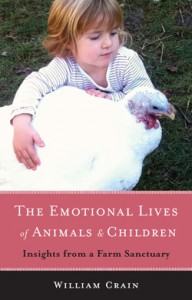
The Emotional Lives of Animals & Children: Insights from a Farm Sanctuary
Divided into two parts, this book first discusses six emotional behaviors that are shared by children and animals: fear, play, freedom, care, spirituality, and resilience. Part two considers children’s place in a society that so often devalues animals.
Children do not set themselves apart from animals, but rather experience them with an instinctive empathy. They have to be taught to detach themselves from animals and view them as inferior to humans. Bill urges us to give children more opportunities to develop their spontaneous feelings for animals and nature.
Whether you are a parent, a caregiver, a teacher, or an animal lover, you’ll find a gentle and reassuring truth throughout these pages: the connection between the natural and human world is not illusive – it is instinctive – and it still exists within all of us.
You can purchase this book on Amazon and other fine booksellers.

Printable Brochure: Questions Answered
Answers to commonly asked questions about an animal-free diet.
Download this double-sided pamphlet as a PDF file, print, and distribute to your community, friends and family.
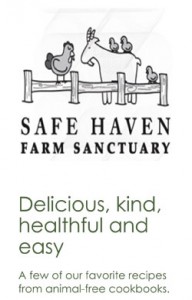
Printable Brochure: Delicious, kind, healthful and easy.
A few of our favorite recipes from animal-free cookbooks.
Download this double-sided pamphlet as a PDF file, print, and distribute to your community, friends and family.
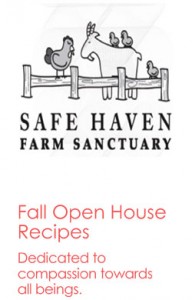
Printable Brochure: Fall 2013 Open House Recipes
Dedicated to compassion towards all beings. These delicious dishes were served at the 2013 Fall Open House at Safe Haven Farm Sanctuary.
Download this double-sided pamphlet as a PDF file, print, and distribute to your community, friends and family.

